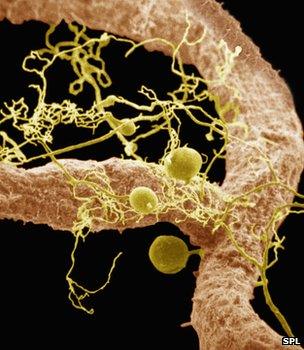Fungus network 'plays role in plant communication'
- Published

Plants can communicate the onset of an attack from aphids by making use of an underground network of fungi, researchers have found.
Instances of plant communication through the air have been documented, in which chemicals emitted by a damaged plant can be picked up by a neighbour.
But below ground, most land plants are connected by fungi called mycorrhizae.
The new study, published in Ecology Letters, demonstrates clearly that these fungi also aid in communication.
It joins an established body of literature, recently reviewed in the Journal of Chemical Ecology and in Trends in Plant Science, which has suggested that the mycorrhizae can act as a kind of information network among plants.
Researchers from the University of Aberdeen, the James Hutton Institute and Rothamsted Research, all in the UK, devised a clever experiment to isolate the effects of these thread-like networks.
The team concerned themselves with aphids, tiny insects that feed on and damage plants.
Many plants have a chemical armoury that they deploy when aphids attack, with chemicals that both repel the aphids and attract parasitic wasps that are aphids' natural predators.
The team grew sets of five broad bean plants, allowing three in each group to develop mycorrhizal networks, and preventing the networks' growth in the other two.
To prevent any through-the-air chemical communication, the plants were covered with bags.
As the researchers allowed single plants in the sets to be infested with aphids, they found that if the infested plant was connected to another by the mycorrhizae, the un-infested plant began to mount its chemical defence.
Those unconnected by the networks appeared not to receive the signal of attack, and showed no chemical response.
"Mycorrhizal fungi need to get [products of photosynthesis] from the plant, and they have to do something for the plant," explained John Pickett of Rothamsted Research.
"In the past, we thought of them making nutrients available from the [roots and soil], but now we see another evolutionary role for them in which they pay the plant back by transmitting the signal efficiently," he told BBC News.
Prof Pickett expressed his "abject surprise that it was just so powerful - just such a fantastic signalling system".
The finding could be put to use in many crops that suffer aphid damage, by arranging for a particular, "sacrificial" plant to be more susceptible to aphid infestation, so that when aphids threaten, the network can provide advance notice for the rest of the crop.
"Now we've got a chance in a really robust manner of switching on the defence when it is needed - not straining the plant to do it all the time - and to reduce the development of resistance (of the aphids to the plants' defences)," Prof Pickett said.
- Published3 January 2009
- Published3 February 2011
- Published27 December 2009